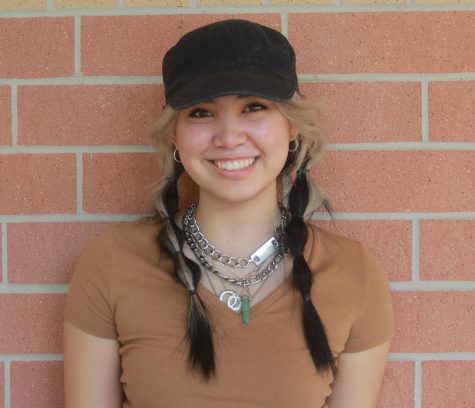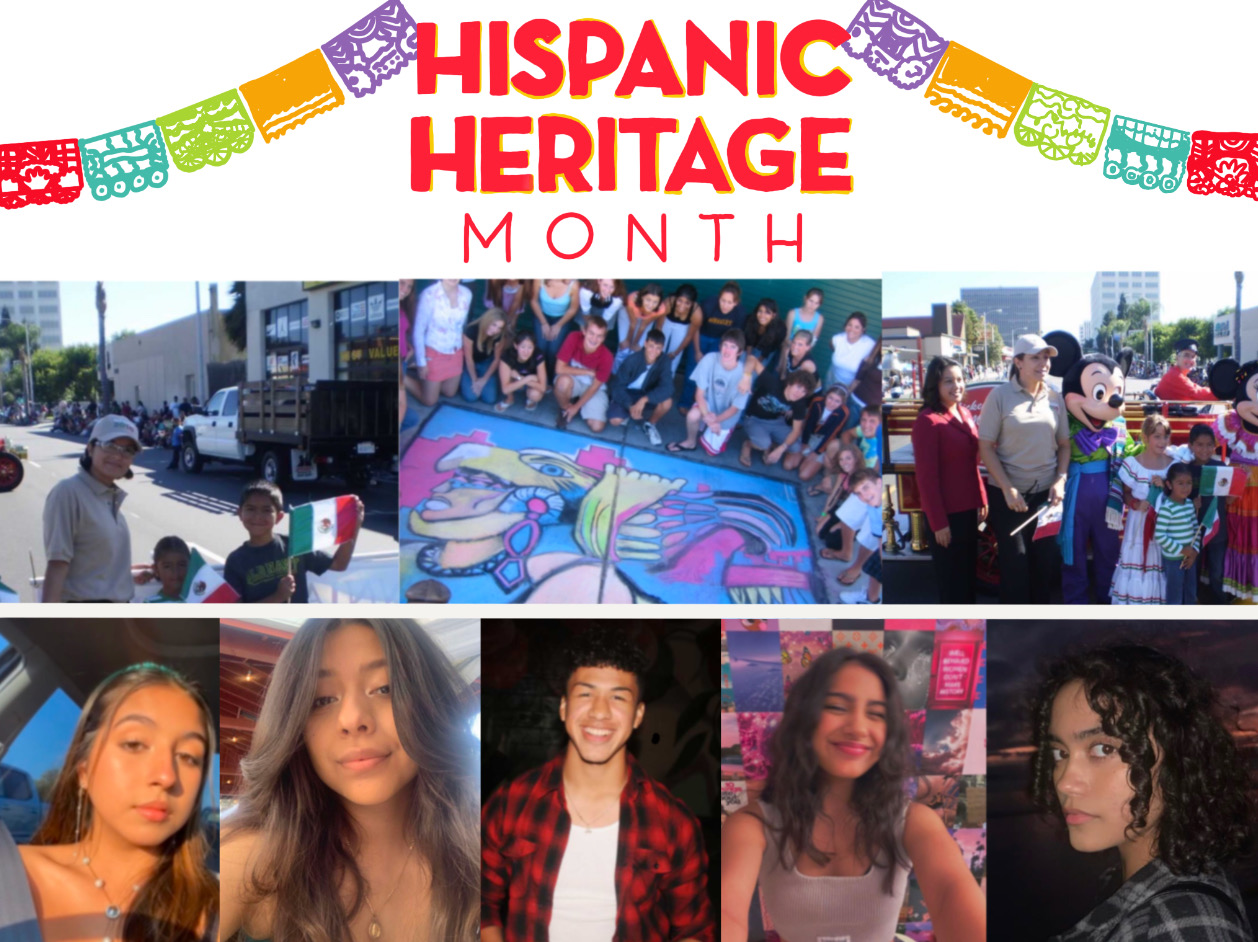
Chloe is a senior and assistant editor of the Sports and Entertainment section. This is her second year on the Gazette staff.

Elise is a senior and Co-editor-in-chief. This is her third year on the Gazette staff.


October 29, 2021
Initially, ‘Hispanic Heritage Month’ was originally observed under President Lyndon Johnson’s presidency in 1968 as ‘Hispanic Heritage Week’.
‘Hispanic Heritage Week’ came to be ‘Hispanic Heritage Month’ in 1988 when President Ronald Reagan expanded the time frame from one week to 30 days.
Hispanic Heritage Month was enacted into law on Aug. 17, 1988.
The start date of the commemoration was chosen to be Sept. 15 as it marks the independence days of several Latin American countries such as Costa Rica, El Salvador, Guatemala, Honduras and Nicaragua though Mexico celebrates on Sept. 16 and Chile on Sept.18.
Within the month, Mexico also celebrates Día de la Raza, or Columbus Day, on Oct. 12.
In Mexico, the month is kicked off with a long-standing tradition—el grito de independencia, a shout of celebration of lasting independence by the president as thousands gather below him in the square to scream along.
2021 marks the 211th anniversary of the ‘Grito De Dolores’, or ‘Call of Dolores’, that effectively ended the Mexican War of independence.
In the US, people celebrate with various festivals and recognition of the holidays that fall within the month.
The US government continues to recognize the significance of Hispanic contributions to history and daily society, through exhibits in the library of congress and Smithsonian museums, and through various presidential proclamations and discussions.
In the last 10 years, the Hispanic population has increased by 23% in the United States in comparison to the overall population which grew by only 4.3%, making this month more important than ever.
“I am Mexican American,” America Leon Arriaga, a senior at GBHS, said.
To Leon Arriaga, Hispanic Heritage Month is a pinnacle of cultural identity.
“Although I usually do not participate in activities concerning Hispanic Heritage Month, as a Hispanic it means a lot. Being born in the United States and having your environment saturated with cultures that do not encompass your own makes it hard to ground yourself and feel a sense of belonging,” Arriaga said. “Being Hispanic, our culture is filled with life, love, family and union. Therefore, being able to see representation during this month brings feelings of joy and connection to the part of me that I sometimes forget to embrace.
Celebrating by immersing herself in the Hispanic community Arriaga and her family attended Hispanic Heritage Month events.
“I have been to a couple of events down in Sacramento as my mom used to work for the Mexican Consulate in which they, along with the community, would host numerous events for Hispanic Heritage Month,” Leon Arriaga said.
The ability to form a connection with heritage, Leon Arriaga clarified, does not always have to stem from attending events.
“Although I do not always go out of my way to go to, or host events, I pride myself in being able to speak my own language,” Leon Arriaga said. “Speaking to my grandparents and going down to Mexico frequently allows me to appreciate my heritage. My family connects me to my background and my culture. Having meaningful conversations and simply listening to my grandparents speak allows me to appreciate and cherish my heritage.”
Finding cultural community Leon Arriaga explains is essential in deepening understanding and appreciation.
Connecting outside of school has been more effective, as Leon Arriaga points out her experience with representation on campus.
“Last year I think, was truly the only time I could say I felt my culture being represented or even talked about (at school),” Leon Arriaga said. “I participated in a class called ethnic studies in which we were able to learn a variety of information on multiple ethnicities, cultures and injustices. In which I was able to share my own experiences, being Hispanic, and learn things about my own culture as well. Apart from that, I can’t really say I have found a cultural community on campus.”
Attending a predominantly white school, Leon Arriaga acknowledges the feelings of seclusion and disconnect in being a minority.
“Already being in a country and a city which id already predominantly white and to be on a campus that is also the same, there is no space in which a kid is able to celebrate their heritage,” Leon Arriaga said. “You are consistently surrounded by, teachers, principles and staff who are not able to relate to who you are as a person or appreciate your culture.”
Aside from the disconnect from the lack of representation, there is a presence of belittlement.
“On top of (the lack of representation), there are kids who will go out of their way to make you feel less than,” Leon Arriaga said.
Belittlement and a lack of representation is detrimental to retaining cultural understanding.
“I have lived in areas in which the schools have been predominantly Hispanic, of all cultures, or predominantly African Americans,” Leon Arriaga said. “Because I have seen it all, I can say that representation is a huge part of how a kid can form themselves. Like the saying goes, ‘you are what you consume and you become who you surround yourself with’, because of that many can tend to lose their culture simply to avoid feeling left out or different.”
Leon Arriaga stresses the need for campuses to provide representation and recognition for minorities most especially during dedicated months of celebration.
“Maybe I’m not looking in the right places (on campus), or I am not looking hard enough, but I still feel like that should not be an excuse as to why I don’t see recognition,” Leon Arriaga said. “To be fair our campus is predominantly Caucasian and representation in really any other ethnicity is rarely seen at all. It’s sad to already see under representation in media and online, only to be shadowed in your own campus again.”
“I am one hundred percent Mexican,” Brianna Valdovinos-Morales, a senior at GBHS, said.
Growing up in a predominantly white area, Valdovinos-Morales emphasized the lack of awareness and recognition which surrounded Hispanic Heritage Month.
“To be honest, I haven’t even noticed there was even a month for Hispanics,” Valdovinos-Morales said. “It was never brought to my attention all throughout elementary school and middle school that we had a whole month to celebrate ourselves. Even in knowing in high school, I feel like there hasn’t been a lot of awareness.”
On campus Valdovinos-Morales focused on the minimal acknowledgment and further lack of action.
“I’ve seen a few posters and it was mentioned on the Granite Bay Today bulletin, but besides that, it’s mentioned and then never brought up again,” Valdovinos-Morales said.
With the lack of celebration, Valdovinos-Morales gestures towards the value of community.
“I’m welcome (at school) but I definitely do have friends who came here and were racially excluded. I had a friend who was going to graduate from here, but then she was bullied here for her race and ethnicity, so she left,” Valdovinos-Morales said. “It really depends on the people you surround yourself with, and I’ve been very thankful to surround myself with lovely people. I don’t have experience (with racially motivated bullying). But I know some other people aren’t as fortunate.”
Finding a sense of community can aid the seclusion which may accompany attending a school as a minority Valdovinos-Morales explains.
“Even with a small Hispanic community, there are still people you can connect to,” Valdovinos-Morales said. “Having friends here that understand your viewpoint helps you to feel more welcomed and understood.”
When asked about the personal meaning of Hispanic Heritage Month, Valdovinos-Morales reflected upon past influential figures.
“(Hispanic Heritage Month) definitely makes me think about my ancestors,” Valdovinos-Morales said. “It also relates directly to big Hispanic or Latinx kind of powerful leaders and the things that they’ve done for us to make our journey and our nation better.”
In celebration, Valdovinos-Morales attended a Latin food and music festival hosted by the Sacramento Hispanic Chamber of Commerce.
“Downtown, I went to an event where it was embracing Mexican music cultures,” Valdovinos-Morales said. “I just tried different Mexican foods kind of like a carnival.”
On a daily basis, Valdovinos-Morales finds ways to personally connect with her heritage.
“I come from a Mexican household. With my parents who don’t really know or speak English, I feel like I always celebrate my culture every day with them,” Valdovinos-Morales said. “I enjoy home-cooked food a lot and embrace stuff like Mexican traditions.”
Hispanic Heritage month’s sentiment of recognition and appreciation carries on into Valdovinos-Morales’ day beyond the span of Hispanic Heritage Month.
“My ethnicity is Mexican,” Savannah Espinoza, a senior at GBHS, said.
Hispanic Heritage Month allows Espinoza to deepen her understanding of history and culture.
“For me, this month is all about learning more about my past and culture,” Espinoza said.
At home, when Espinoza does celebrate she does so with her family.
“I would say I somewhat celebrate Hispanic Heritage Month,” Espinoza said. “My mom usually is busy but she tries to cook more traditional meals for me and my sister.”
At-home families pay homage to Hispanic Heritage Month, but at school Espinoza noticed a lack of knowledge and a lack of effort to acknowledge other cultures.
“I personally connect with my heritage through my family,” Espinoza said. “But (at school) I feel like there could be more recognition not just for Hispanic Heritage Month but for every heritage month. I feel like some teachers try to talk about it and spread information but for the most part, people are unaware of the month altogether. Even just a small summary showed in every class about Hispanic culture could enlighten a lot more students and staff.”
Moving forward, Espinoza hopes to see a greater appreciation for other cultures on campus.
“I am a Nicaraguan-American,” Giselle Gutierrez said.
Gutierrez is a junior at Granite Bay High School.
For Gutierrez, Hispanic Heritage Month doesn’t have any particular traditions, but is a time of celebration of her Latina heritage and connection to other Hispanic people.
“This month is the time of the year in which I can share my pride in being Latina with others and connect with other Hispanic people. I appreciate hearing the joys and struggles other Hispanic people have experienced being on campus and in their communities.”
As Gutierrez took Spanish classes in high school and began to take interest in things such as Hispanic culture, she first turned to her family to learn more.
“I ask my parents to tell me stories of their childhoods and to do my research into the history and the current state of Nicaragua…I would like to take the time to visit my family more often and talk to those still in Nicaragua.” Gutierrez said.
Gutierrez feels that learning Spanish gave her more chances to appreciate Hispanic culture.
“My entire family speaks Spanish, and when I was younger I was unable to communicate with them, except for a few simple phrases. Now, after learning Spanish both at school and home, I have this ability to converse, allowing me to make new memories with my relatives,” Gutierrez said.
Gutierrez also appreciates making these connections and strides outside of her home, and sees improvements being made in how Granite Bay recognizes Hispanic Heritage Month.
In particular, Gutierrez believes that most of the recognition is from Spanish classes, which focus on culture as part of learning the language.
“I believe Granite Bay does a good job in recognizing this month, through the Bulletin, teacher announcements, and this edition of the Gazette. This topic has been brought up in most of my classes, and each time I hear of it I smile,” Gutierrez said.
While this benefits students taking these classes and allows them to have a better understanding of Hispanic culture and tradition that translates to more opportunities and appreciation for Latinos, not everyone is in a Spanish class that brings up these topics, which is where the school has the availability to come in and do more.
“Mrs. Gonzales does an excellent job of communicating the significance of HHM, making all Latinos feel special whilst still educating everyone,” Gutierrez said.
Learning about the history of Hispanic Heritage throughout this month is just the beginning, as it is also a time to reflect on what opportunities and resources the communities, schools and government can provide, aiding the next generation of Latino- American history makers.
On top of education, resources that the school can provide during the month and year round for those who want to learn about Hispanic culture and students of Hispanic descent is something that Granite Bay can improve on.
“I would like for there to be resources in which aid students in signing up for scholarships, SATS, AP exams, etc. as many first-generation Latino-Americans cannot ask their parents questions or for help on how to do these things,” Gutierrez said.
As Gutierrez continues to learn Spanish and cook Nicaraguan food with her family, her celebration of her culture and ancestors will continue even after the month comes to an end.
Anna Marie Gonzalez prioritizes culture lessons in her Spanish classes at Granite Bay High School, and focuses on Mexican independence day to kick off Hispanic Heritage Month.
Gonzalez teaches Spanish 3 and IB Spanish classes, both of which incorporate valuable cultural lessons and reflections throughout the year.
Her favorite tradition- the chalk murals she did for years with her classes to learn about different Hispanic artists and classic images, while creating art for the school to enjoy.
While Gonzalez continues these lessons during Hispanic Heritage month, she also enjoys learning from other presentations and events throughout the month.
“I’ve noticed this, this year…in the evenings on Channel 40 around 7:30…there’s about a half an hour dedicated exclusively to someone in the community or something Hispanic related and so I’m learning stuff every day.”
The news source featured various artists and local Hispanic business owners, which Gonzalez hoped others learned from as well.
One lesson Gonzalez realized not everyone knows is the separation between Cinco De Mayo and Mexican Independence day.
“I’m always learning new stuff and I feel like that I hope that they, at the very minimum, recognize when we actually celebrate ourselves and our separation from Spain, but also that they just learn a little bit more,” Gonzalez said.
The end of Hispanic Heritage Month is also something Gonzalez looks forward to every year, as it indicates that Dia De Los Muertos, or Day of The Dead, is quickly approaching.
Growing up, Gonzalez’ favorite holiday was Dia De Los Muertos, which is celebrated the first few days of November.
“It was my best friend’s holiday,” Gonzalez said.
The days are a time to remember family members and friends who have passed on and one’s ancestors.
Though the holiday has religious origins, the popularity of it today is very mainstream, and part of that is reflected in the decorations and festivities associated with the celebration.
Gonzalez’ room is as festive as it gets, and she dedicates space to feature pictures of her family and the friend, who passed away 10 years ago, who so much loved the holiday.
“As much as I miss her, it’s a good day,” said Gonzalez.
Dia De Los Muertos has joined many other Hispanic cultural traditions in mainstream media in the United States, such as in the movie Coco.
This recent expansion, seen in Hollywood and the growth of Spanish music, encourages Gonzalez who remembers many stereotypes and poor representation in the recent past.
“Hispanics were either the villains…and so it’s been a long time to change the idea of who we are, and stop stereotyping us,” Gonzalez said.
Each year Gonzalez sees improvement, which is the goal of Hispanic Heritage Month.
“I wonder if those people feel the same sense of pride as I do, because I know for me it touches my heart,” Gonzalez said. “I’m proud to be a strong Latina.”

Chloe is a senior and assistant editor of the Sports and Entertainment section. This is her second year on the Gazette staff.

Elise is a senior and Co-editor-in-chief. This is her third year on the Gazette staff.
Jim Batz • Nov 30, 2021 at 8:48 pm
Awesome article highlighting Hispanics and their heritage. Can’t wait for White History Month in January.